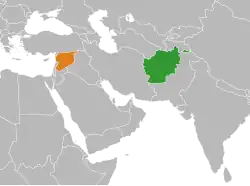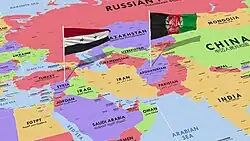Afghanistan–Syria relations
 | |
Afghanistan |
Syria |
|---|---|

Following a swift military offensive in late 2024, the Islamist group Hay’at Tahrir al-Sham (HTS) seized control of Syria, ending Bashar al-Assad’s long-standing rule and ushering in a new regime led by Ahmad al-Sheraa (formerly Abu Mohammad al-Jolani), who also heads HTS. Though HTS has officially distanced itself from al-Qaeda since 2016, lingering ties remain, and the group is still designated as a terrorist organization by several Western nations. HTS shares ideological roots with the Taliban,[1] both being Sunni Islamist groups—HTS leaning Salafist and the Taliban following Hanafi jurisprudence—yet no formal alliance exists. The groups express symbolic mutual support[2] and share common enemies like ISIS, but their strategies remain distinct, with the Taliban largely focused on national governance in Afghanistan under Hibatullah Akhundzada’s leadership. Al-Qaeda’s leadership structure has remained murky since Ayman al-Zawahiri’s death, with decentralized factions still operating in various regions. While HTS seeks to portray itself as a national Syrian movement[3] and the Taliban as a stabilizing force, their historical and ideological links to al-Qaeda continue to raise international concerns about extremism, governance, and regional security.
History
Between 2001 and 2011, relations between the Assad regime in Syria and the Afghan government (prior to the Taliban's return) were minimal and largely indirect. Syria, under Bashar al-Assad, maintained a foreign policy focused on regional alliances—particularly with Iran and Hezbollah[4]—and was largely isolated from Western-backed governments like post-Taliban Afghanistan. Both countries were preoccupied with internal challenges: Syria with growing unrest and authoritarian consolidation,[5] and Afghanistan with rebuilding[6] under U.S. and NATO influence. There’s little evidence of formal diplomatic or strategic engagement between the two during this period.
Between 2011 and 2021, relations between the Assad regime in Syria and Afghanistan remained distant and largely symbolic. Syria was deeply embroiled in its civil war, relying heavily on support from Iran and Russia,[7] while Afghanistan—under the Western-backed government—focused on internal security and reconstruction. The two governments had no significant bilateral cooperation, and their foreign policy priorities diverged sharply. Syria’s alignment with anti-Western blocs contrasted with Afghanistan’s dependence on U.S. and NATO forces. Any diplomatic contact during this period was minimal and overshadowed by broader regional dynamics.
Between 2021 and 2024, relations between the Assad regime in Syria and the Taliban government in Afghanistan were largely symbolic and ideologically distant. While both regimes shared authoritarian tendencies and Islamist rhetoric, they operated in vastly different geopolitical spheres. Syria remained closely aligned with Iran and Russia, whereas the Taliban sought legitimacy and recognition amid growing international isolation. There’s little evidence of formal diplomatic engagement between the two, though the Taliban reportedly celebrated the fall of Assad[8] in late 2024, viewing it as a symbolic victory for Islamist movements. However, the rise of Syria’s new leadership under Hayat Tahrir al-Sham (HTS) introduced ideological contrasts that may challenge the Taliban’s hardline stance.
On July 3, 2025, Russia became the first country to officially recognize the Taliban regime as the legitimate government of Afghanistan.[9] The announcement followed a meeting in Kabul between Russia’s ambassador Dmitry Zhirnov and Taliban Foreign Minister Amir Khan Muttaqi,[10] marking a significant shift in international diplomacy and opening the door to deeper bilateral cooperation.
References
- ^ Sirat, Siyar (2024-12-09). "Fall of Syria's Assad sparks comparisons with Afghanistan". Amu TV. Retrieved 2025-07-27.
- ^ "Syria's top extremist group HTS hails Taliban takeover of Afghanistan". Al Arabiya English. 2021-08-18. Retrieved 2025-07-27.
- ^ "HTS seeks public legitimacy". DIIS. Archived from the original on 2025-02-17. Retrieved 2025-07-29.
- ^ "Axis of Resistance | Groups, Countries, Map, Leaders, Middle East, Iran, Hezbollah, Hamas, Syria, & Houthi | Britannica". www.britannica.com. 2025-06-23. Retrieved 2025-07-29.
- ^ "Syrian unrest – DW – 03/27/2011". dw.com. Retrieved 2025-07-29.
- ^ "Rebuilding Afghanistan". georgewbush-whitehouse.archives.gov. Retrieved 2025-07-29.
- ^ "The Treacherous Triangle of Syria, Iran, and Russia | The Washington Institute". www.washingtoninstitute.org. Retrieved 2025-07-29.
- ^ "Taliban mark Assad's fall with rallies, sweets, and solidarity messages". Centre for Information Resilience. 2025-07-24. Retrieved 2025-07-29.
- ^ "Afghanistan: Russia recognizes the Taliban government – DW – 07/06/2025". dw.com. Retrieved 2025-07-29.
- ^ AFP (2025-07-03). "Taliban praise Russia's 'brave decision' to recognise their rule in Afghanistan". The Guardian. ISSN 0261-3077. Retrieved 2025-07-29.